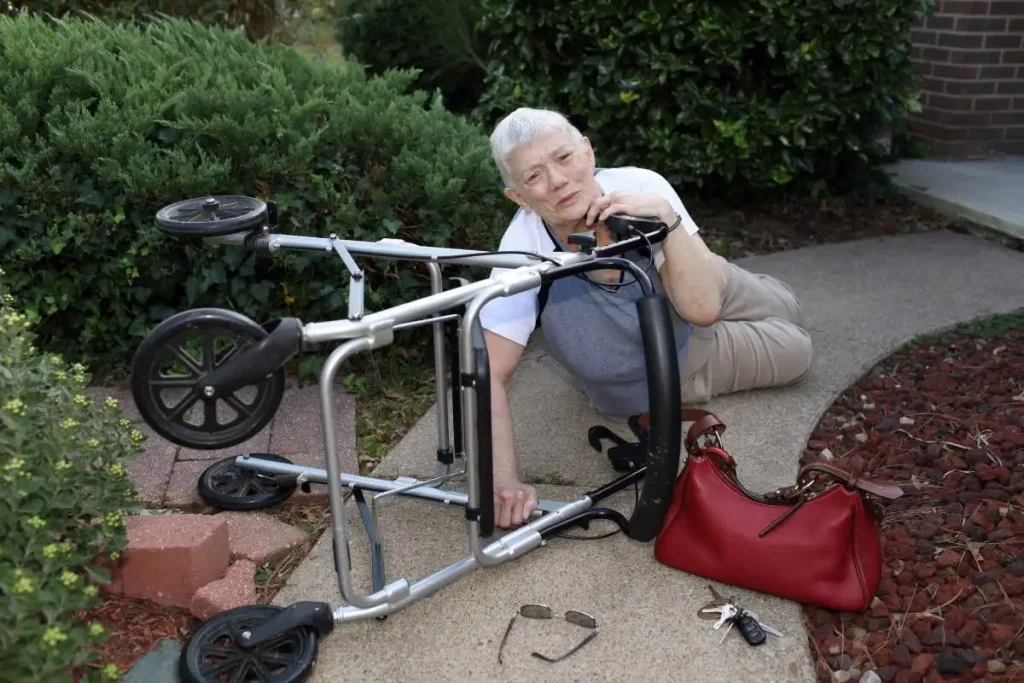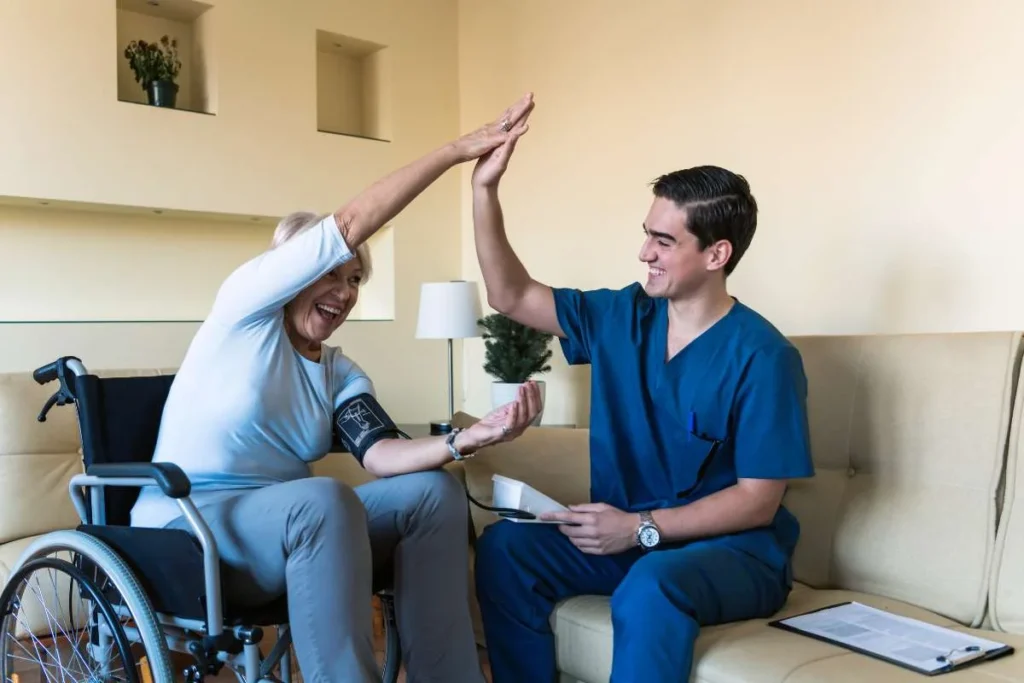Home safety is essential for preventing falls among seniors. Evaluating the environment can reveal areas that pose risks and opportunities for improvement. Addressing these factors will create a safer living space.
Identify High-Risk Areas
Seniors should focus on specific areas in the home where falls are more likely to occur. Common high-risk zones include:
- Stairs: Ensure that handrails are securely installed on both sides. Stairs should be free of clutter and well-maintained.
- Bathrooms: Slippery surfaces can increase fall risk. Look for places near the tub, shower, and toilet.
- Kitchens: Spills and clutter can contribute to accidents. Pay attention to flooring and storage setups.
Regularly assessing and documenting these areas will help prioritize safety improvements.
Install Safety Devices
Safety devices are crucial for fall prevention. Several key devices can enhance safety within the home:
- Grab bars: Install grab bars in bathrooms, particularly near toilets and in showers or tubs. This provides stability while maneuvering.
- Non-slip mats: Using non-slip mats in bathrooms and kitchens can help prevent slips on wet surfaces.
- Stairlifts: For seniors with mobility issues, stair lifts can ensure safe navigation between floors.
Incorporating these devices not only adds safety but also creates peace of mind for both seniors and their families.
Secure Rugs and Carpets
Loose rugs and carpets can be significant hazards. Seniors should take the following steps to secure flooring:
- Remove or secure loose rugs: Either eliminate unsecured rugs entirely or use double-sided tape to keep them in place.
- Choose flat carpets: Opt for low-pile carpets that minimize trip hazards.
- Check edges: Ensure that all carpet edges are secured to the floor to prevent lifting or curling.
Addressing flooring issues can significantly reduce the likelihood of falls in the home.
Improve Lighting Conditions
Adequate lighting is vital for preventing falls. There are several strategies to enhance visibility and reduce risks:
- Brighten key areas: Install brighter bulbs in hallways, staircases, and entryways to improve visibility.
- Use night lights: Place night lights in bedrooms, bathrooms, and hallways to provide illumination during the night.
- Eliminate shadows: Keep light fixtures clean and consider adding additional lighting in darker corners or areas.
By improving lighting, seniors can navigate their homes more safely and confidently.
Enhancing Mobility
Improving mobility is crucial for seniors to maintain independence and reduce the risk of falls. Key aspects include promoting regular exercise, selecting proper footwear, and providing mobility aids. Each of these elements plays a significant role in enhancing physical stability.
Encourage Regular Exercise
Regular exercise helps improve balance, strength, and flexibility. Engaging in activities such as walking, swimming, or yoga can be beneficial. Balance exercises, like standing on one leg or using a balance board, should be emphasized.
Strength training with light weights or resistance bands can enhance muscle support. Aim for at least 150 minutes of moderate exercise per week, spread over several days. Group classes or community programs may provide motivation and social interaction.
Seniors need to consult a healthcare provider before starting any new exercise regimen. Personalized programs can address individual health conditions, ensuring safe and effective participation.
Selection of Appropriate Footwear
Choosing the right footwear is critical for stability. Seniors should opt for shoes with good grip and non-slip soles to prevent slipping. Shoes should also provide adequate cushioning and support for the arch and heel.
Avoid high heels and flip-flops, as they can increase the risk of falls. Footwear should fit well, allowing enough room for toes without being too loose. A snug fit prevents blisters and allows for better control.
Consider custom orthotics if necessary, especially if foot problems are present. These can enhance comfort and improve alignment, further supporting mobility efforts.
Provide Mobility Aids
Mobility aids can significantly enhance safety and mobility for seniors. Options include canes, walkers, or mobility scooters, depending on individual needs. They provide stability and support while navigating various terrains.
When selecting a mobility aid, consider the user’s specific challenges. A healthcare professional can recommend the appropriate type and size. The aid must be adjusted properly to the user’s height to ensure effectiveness.
Regular assessment of the mobility aids is essential. Ensure they are in good condition and are being used correctly to maximize safety and mobility.
Bathroom Safety Measures
Ensuring safety in the bathroom is essential for preventing falls among seniors. Implementing specific installations and selecting appropriate equipment can significantly reduce risks.
Install Grab Bars
Grab bars provide vital support for seniors when moving in and out of the shower or bathtub. Installing them near the toilet and inside the shower is crucial.
Placement Considerations:
- Position bars at appropriate heights for the individual’s reach.
- Consider installing multiple bars for various movements, such as standing, sitting, or transitioning.
Material and Design:
- Choose grab bars made of sturdy materials like stainless steel.
- Look for textured surfaces to prevent slipping.
Regularly check the stability of installed grab bars. Ensuring they are securely anchored will enhance safety during use.
Use Non-Slip Mats
Non-slip mats are essential for preventing slips and falls in wet areas. These mats should be placed both inside and outside the shower or bathtub to provide traction.
Key Features:
- Select mats with suction cups on the bottom to secure them in place.
- Ensure they are easy to clean and maintain hygiene.
Placement Tips:
- Cover high-risk areas, such as the shower floor and adjacent bathroom floors.
- Avoid mats that are too thin or easily movable, as they may pose additional hazards.
Regularly inspect the mats for wear and replace them if they lose their non-slip properties.
Consider a Shower Chair
A shower chair offers a stable seating option for seniors who may struggle with balance while bathing. This addition allows them to sit while showering, reducing the risk of falls.
Benefits:
- Provides a safe place to sit and rest.
- Encourages independence while maintaining safety.
Types of Shower Chairs:
- Look for adjustable height options to accommodate different individuals.
- Choose chairs with non-slip feet and sturdy arms for added support.
Regular maintenance is essential. Check for any wear and ensure the chair is securely placed before each use.
Minimizing Hazardous Behaviors
Addressing hazardous behaviors is crucial for fall prevention among seniors. By educating individuals on safe movement and discouraging risky activities, the likelihood of falls can be significantly reduced.
Educate on Safe Movement
Education is key in promoting safe movement. Seniors should be instructed in proper techniques for getting up from a seated position, walking, and using assistive devices.
Demonstrations can be effective. For instance, using an upright posture while walking helps maintain balance. Emphasizing the use of proper footwear is also essential; shoes should have non-slip soles and fit well.
Creating a checklist can reinforce safe practices. This checklist might include:
- Use handrails on stairs.
- Practice walking in a straight line.
- Seek assistance when needed.
Regular reminders can help integrate these practices into daily routines, enhancing safety.
Discourage Risky Activities
Identifying and discouraging risky activities can further prevent falls. Seniors should be advised against actions that compromise their stability, such as climbing on chairs to reach high shelves or participating in activities without supervision.
Regular assessments of home environments can highlight potential hazards. For example, removing clutter from walkways minimizes tripping risks.
Communicating the importance of adhering to safety protocols when engaging in activities like gardening or housework is essential. Prioritizing less hazardous methods, such as using step stools with safety features, can also greatly improve safety outcomes.
Encouraging social activities that involve safe movement, like walking groups, can promote both physical fitness and safety awareness.
Medical Management
Attention to medical management is essential for preventing falls in seniors. Proper medication management, monitoring of health conditions, and scheduling regular check-ups can significantly reduce the risk of accidents and enhance overall well-being.
Review Medications
Seniors often take multiple medications, which may increase the risk of side effects that contribute to falls. It is vital to review medications regularly with a healthcare provider.
- Identify High-Risk Medications: Be aware of medications that may cause dizziness, drowsiness, or balance issues, such as sedatives or certain blood pressure drugs.
- Consider Alternatives: Discuss potential alternatives or adjust dosages with healthcare professionals.
Keeping an updated list of medications, including dosages and purposes, can also assist in understanding their effects.
Monitor Health Conditions
Ongoing monitoring of chronic health conditions is crucial for maintaining stability and strength.
- Balance and Strength: Conditions such as arthritis or Parkinson’s disease can affect mobility. Regular assessments should focus on balance exercises and strength training.
- Vision and Hearing: Regular tests for vision and hearing can help identify issues that might contribute to falls. Addressing these problems promptly, such as getting glasses or hearing aids, can improve safety.
Engaging with health professionals about these conditions ensures that seniors receive the necessary interventions and support.
Schedule Regular Check-ups
Regular medical check-ups facilitate the timely identification of health issues and necessary adjustments in care plans.
- Set a Routine: Scheduling check-ups at least once a year—or more frequently if necessary—can help keep health conditions in check.
- Preventative Care: These visits often include assessments for fall risk and recommendations for preventive measures, such as physical therapy or home modifications.
Active participation in healthcare helps seniors remain informed and proactive about their health, ultimately reducing fall risk.
Nutrition and Hydration
Proper nutrition and hydration play crucial roles in fall prevention for seniors. A balanced diet provides essential nutrients that support muscle strength and coordination. Adequate fluid intake helps maintain hydration, which is vital for overall health and cognitive function.
Promote a Healthy Diet
A nutritious diet for seniors should include a variety of food groups. Focus on:
- Fruits and Vegetables: Aim for at least five servings daily. They provide vitamins and antioxidants.
- Whole Grains: Choose whole-grain bread, cereals, and pasta. They offer fiber and support digestive health.
- Lean Proteins: Incorporate options like fish, poultry, beans, and low-fat dairy. Protein is essential for muscle maintenance.
Including healthy fats, such as those found in nuts and avocados, can also benefit overall health.
The Mediterranean diet is often recommended, as it’s rich in nutrient-dense foods. Regular meals can prevent fatigue and maintain energy levels, reducing the risk of falls.
Encourage Adequate Fluid Intake
Proper hydration is essential for maintaining physical function. Seniors are at risk for dehydration due to decreased thirst sensation. Encouraging fluid intake can help mitigate this risk.
- Water: Aim for at least 8 cups daily, unless otherwise advised by a doctor.
- Hydrating Foods: Incorporate foods with high water content like cucumbers, oranges, and watermelon.
- Limit Caffeine and Alcohol: These can contribute to dehydration. Choose alternatives like herbal teas or diluted juices.
Establishing a routine for fluid intake, such as drinking water after meals or setting reminders, can help. Keeping water accessible throughout the day may also encourage increased consumption.
Emergency Preparedness
Being prepared for emergencies can significantly enhance safety for seniors. Establishing a clear plan and ensuring access to communication devices are essential steps.
Establish a Response Plan
A well-defined response plan is crucial for handling emergencies effectively. This plan should outline specific actions to take during various scenarios, such as falls, health crises, or natural disasters.
- Identify Key Contacts: List family members, friends, and emergency services. Include their phone numbers and emails for quick access.
- Designate Roles: Assign specific responsibilities to family members or caregivers. This may include who to call, who will provide assistance, or who will reach the senior’s location.
- Practice Drills: Conduct regular practice drills to ensure everyone is familiar with the plan. This builds confidence and helps identify areas for improvement.
- Update Plan Regularly: Review and adjust the plan as needed. Changes in health status or living conditions may necessitate updates.
Maintain Access to Communication Devices
Having accessible communication devices is vital for senior safety. These devices enable quick access to help when needed.
- Mobile Phones: Ensure that mobile phones are charged and nearby at all times. Consider equipping the senior with a phone that has large buttons and clear displays.
- Emergency Alert Systems: Explore options for wearable emergency alert systems. These devices allow seniors to summon help with the press of a button.
- Landline Phones: If applicable, maintain a functional landline phone. They can be easier to use during emergencies and don’t require battery power.
- Checklist for Readiness: Regularly check that all devices are in working order. This includes testing mobile phones, charging stations, and alert systems.
Implementing these strategies can foster a safer and more responsive environment for seniors in case of emergencies.
Professional Support Services
Professional support services play a crucial role in fall prevention for seniors. They provide tailored assistance focused on individual needs, enhancing safety and mobility.
Consider Home Care Assistance
Home care services offer vital support for seniors who require help with daily activities. Caregivers can assist with:
- Personal Care: Help with bathing, dressing, and grooming.
- Mobility Support: Safe navigation around the home using assistive devices.
- Medication Management: Ensuring the correct intake of prescribed medications.
Having a dedicated caregiver not only reduces the risk of falls but also provides companionship. This social interaction can keep seniors engaged and alert. Regular check-ins also promote early detection of any health changes that may affect mobility.
Explore Physical Therapy Options
Physical therapy focuses on improving strength, balance, and coordination. A licensed physical therapist evaluates individual risks and develops a personalized exercise regimen. Key components may include:
- Balance Training: Exercises designed to enhance stability.
- Strength Training: Increasing muscle strength to support mobility.
- Gait Training: Teaching safe walking techniques.
Regular physical therapy sessions can significantly reduce fall risks. The therapist can also educate seniors on how to navigate their surroundings safely. Additionally, they can recommend home modifications, such as grab bars or improved lighting, to enhance safety.





